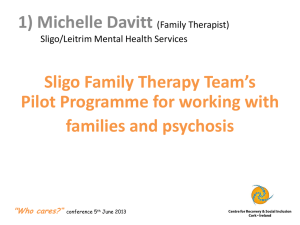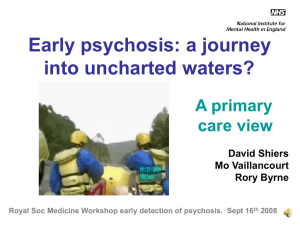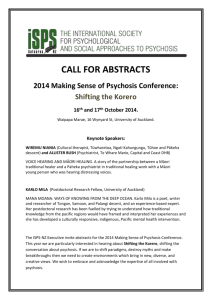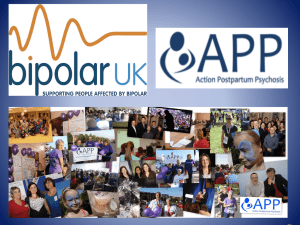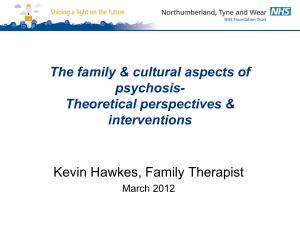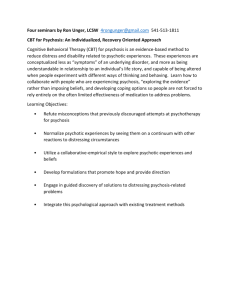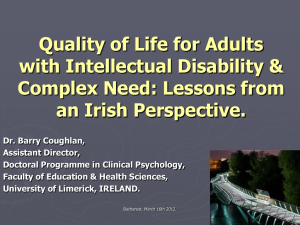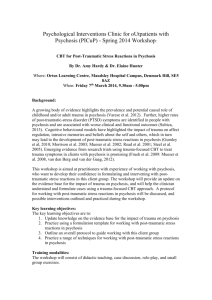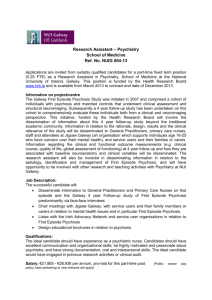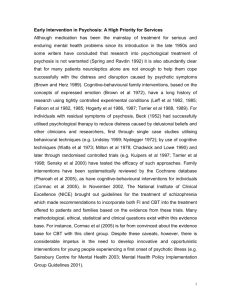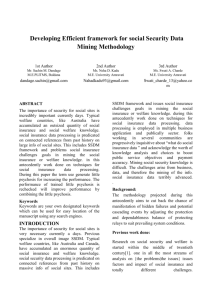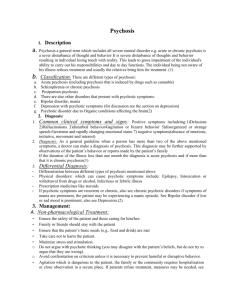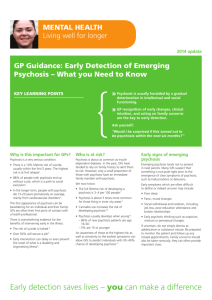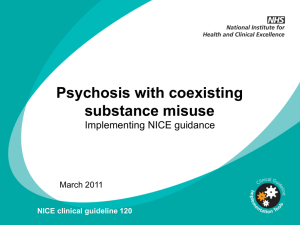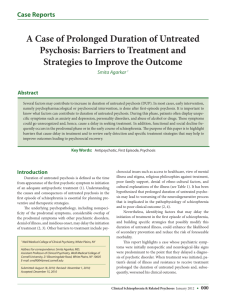bestpracticeinpsychosis
advertisement
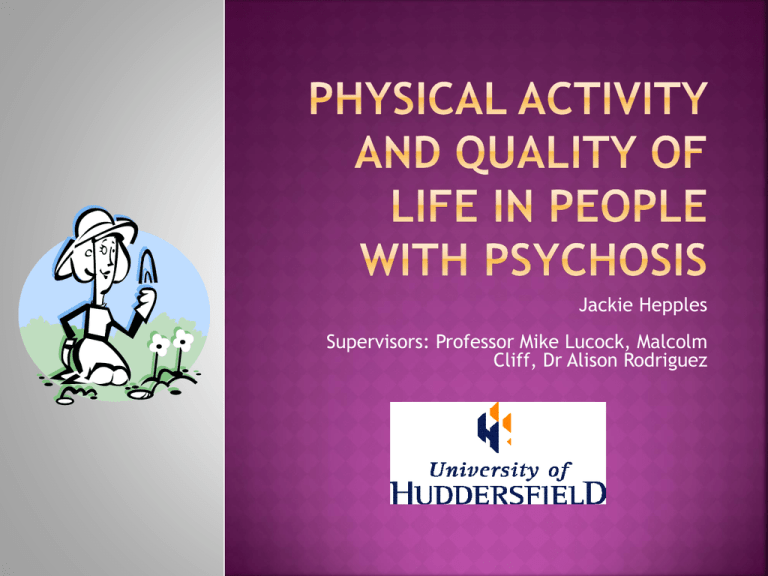
Jackie Hepples Supervisors: Professor Mike Lucock, Malcolm Cliff, Dr Alison Rodriguez Background to physical activity (PA) and quality of life (QoL) Focus group questions in two’s or threes Results Questions QoL is poor in people with psychosis White Paper: Choosing Health (Department of Health, 2004) From Values to Action: The Chief Nursing Officers Review of Mental Health Nursing (Department of Health, 2006) Recovery model Physical activity: ‘any bodily movement produced by muscles that results in energy expenditure’ Barry on swimming: “ Well, it got me out, for a start. Something new, something I hadn’t done in a long time. And I felt better for it, felt I benefited from it a bit, you know. I felt a bit more mobile, getting around in general seemed to be a bit easier….I felt a bit selfstimulated, a bit proud of myself. I was actually doing something that was worthwhile and slightly constructive” (Faulkner & Sparkes, 1999). Physical health Mental health Social health Limited research Difficulties with population Limited cross-sectional research Limited exploratory research To investigate if and how physical activity is beneficial to quality of life in people with psychosis. 1) To investigate the relationship between physical activity and quality of life in people with psychosis. 2) To explore the experiences of physical activity in people with psychosis 3) To explore the perceptions and experiences of mental health staff with regard to physical activity and quality of life in people with psychosis. Study 1 Is there a relationship between physical activity and quality of life? How does this relate to Self-Determination Theory? Quantitative If there is a relationship between PA and QOL what are the reasons for this? What are the benefits and barriers? Why do Are the people do physical results of activity? the studies similar or do they differ? Study 2 Explore the lifeworld of people with psychosis and their experiences with physical activity Qualitative Physical activity and quality of life in people with psychosis Do staff and service users have the same or different perspectives of physical activity? What reasons do staff give to any potential relationship? What are the perceived benefits and barriers of PA and interventions? How can PA be implemented? What is the rationale for providing PA interventions? Study 3 What are the experiences and perceptions of staff with regards to physical activity and quality of life. Qualitative Study 1: Self-report measures of PA, QoL, SDT & depression Convenience sample through CMHTs, Assertive Outreach, Early Intervention, Outpatient clinics Multiple Regressions Study 2: Interviews with active people with psychosis Template Analysis Interpretive phenomenology Study 3: Focus groups Template Analysis Interpretive phenomenology Right hand side of the room Centre of the room Left hand side of the room What PA services do you know of? How do you think PA would affect somebody with psychosis? Problems of implementing PA in people with psychosis? Why do you think these services are provided? Any benefits of introducing PA services? Would PA benefit/worsen the service you provide? What are your experiences of PA in people with psychosis? How? What do you thin prevents people from being active? 72 participants Physical QoL Mental QoL Physical Activity r = 0.389 r = 0.161 p = 0.001* p = 0.100 Physical QoL r = -0.098 p = 0.209 Autonomy Competence Relatedness r = 0.237 p = 0.028* r = 0.225 p = 0.035* r = 0.260 p = 0.018* r = 0.197 p = 0.52 r = 0.166 p = 0.087 r = 0.27 p = 0.412 Participants Male Female Bipolar Disorder 2 2 Schizophrenia 3 1 Semi-structured 45 interviews – 70 minutes Confidential room Physical activity (PA) and Quality of Life 1. Empowerment and strive for normality 1.1. Cope with symptoms 1.2. Cope with medications 1.3. Day-to-day life 2. Confidence 2.1. Body image 2.2. Achievement 2.3. Platform for future aspirations Mike and Tina 21 years old Schizophrenia Never engaged in structured physical activity before diagnosis. Illness drove physical activity Empowerment and strive for normality PA and coping with symptoms ‘me favourite one for doing me good is boxing. I hear voices all the time and when I do I go boxing for an hour and a half, I don’t hear one voice I think it’s really weird cos they say relaxing can help, when I relax they get louder, the voices and when I do boxing on a punch bag they go completely so that’s my favourite one, I seem to come out with a really clear head, like I haven’t even got a mental illness’ PA and coping with medication ‘it’s better than feeling lethargic I find, it’s just better than feeling lethargic, that’s all I can think really, you feel just about like everyone else feels when you’ve done exercise you know what I mean, I don’t know how you feel, a bit of adrenaline maybe, clear head it seems to clear your head a bit doesn’t it’ “I were doing some press-ups actually in hospital and they said you can stop them you’re here to rest, so I stopped doing that and erm rested up and it just made me worse you know what I mean, just sinking back into chair it just felt like I was sinking back into chair, I was getting depressed, I went really lethargic and I didn’t like it one bit” However........... Chose to undertake physical activity Meaningful activity in control of illness ‘like I haven’t even got a mental illness’. Tina 34 years old Bipolar Disorder Consistently struggled with weight and participated in physical activity on and off Weight loss was motivation for physical activity Confidence PA and body image ‘I feel as though I’m working towards looking good in my clothes. Looking good when I go out, people don’t look at me and think ‘god isn’t she fat’ you know what I mean which is what they used to do before which has added to my bipolar syndromes because it made me feel like down here because people were looking at me and judging me and they didn’t even know me do you see what I mean, but now when I look in the mirror and I like what I see and it’s been hard but I’ve done it’ PA and platform for the future “because I feel good about myself I want to more, does that make sense? like I’m looking at things like I’ve always wanted to do, like car body parts...I think I’m going to do it and my boyfriend’s like ‘are you sure?, you know it’s at night during the week in September and you’d have to go and mix with others’ cos I’m not good with groups and stuff and I’m like ‘I really want to do it’, I look good, I want to do it I feel better, I’m exercising I feel as though I’m at a stage of me life where everything’s coming together I want to do it and I’m getting to that stage now where I’m getting a little bit more adventurous, that’s because I feel good though, does that make sense?” Improved self-perception More confidence Recovery & enhanced quality of life Frequency Intensity Type Time Experience providing meaning and purpose Mike: purpose was to control illness Tina: purpose was to improve self For others part of a former self was recovererd Autonomous Stage of illness Balance of medications Meaningful Environment Type 9 participants 2 focus groups Early Intervention team Mix of service leads, psychiatrist & support worker Results......... Key points: PA is seen as beneficial Difficult to promote because of time constraints PA is implemented bottom-up Would worry if it became top-down Physical activity is related to physical quality of life Could be explained through change in body image/fitness Quant study found no relationship between PA and mental quality of life Qual study found that PA is beneficial to mental quality of life Difficult to separate the mind and body; Treat one you treat the other.
